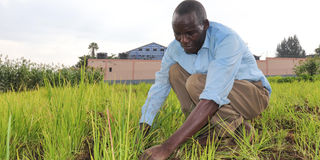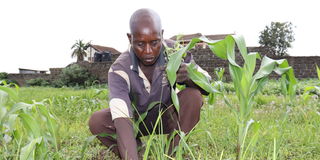Daring Kiamunyi farmers dig their feet into millet farming

Nemuel Ondari weeding his millet crop at his farm in Kiamunyi.
In a county heavily reliant on maize production, there are only a handful of farmers diversifying their cultivation with finger millet (wimbi) farming in Nakuru.
At first glance, you’d think it's grass. However, seeing it intercropped with other crops, the perception swiftly shifts.
A few kilometres from town in Kiamunyi-London ward, are small-scale millet farmers doing their first round of weeding.
Mtaa Wangu observed farmers having squatted, bent, and seated, including George Muchiri and Gladys Omari, on their farm which is a little over an acre, diligently tending to their crops on the farm, their hands busy pulling out weeds.
A crouched Muchiri notes being in their second week of weeding and highlights the importance of precision in the job as one can accidentally uproot the millet.

A kilogram of millet goes for Sh 110 in Nakuru's bargain cereal market on June 10, 2024.
“Millet, like maize, is weeded two times. Some farmers do it once, but if you want good results, it is best to weed twice. However, due to its time and labour-intensive nature, many people shy away from cultivating this crop,” he opines.
Gladys, who uses a small combined fork and jembe first to soften the soil before uprooting, says she is doing so because it reduces the strain on her hands, making the task less tiresome.
There is also an alternative to seek out labourers to weed, which Gladys notes is expensive as it costs Sh. 400 on 10 feet by 10 feet, therefore opting to do it alone.
Muchiri notes that millet is a crop they traditionally cultivated when they were younger in the rural area. They opted to continue farming it not only for the numerous health benefits but equally for the prices it fetches in the market.

George Muchiri explains why weeding millet is a delicate affair while at his farm in Kiamunyi.
Nemuel Ondari, who has planted millet on three-quarters of his acre farm, agrees with Muchiri’s sentiments that the crop is very high-yielding compared to the other crops he is cultivating- sweet potatoes, beans, and sorghum.
With good care, the farmers note that one can yield 10 to 15 bags of 90 kg each per acre, with a bag ranging from as low as Sh. 8,000 to as high as Sh. 12,000.
Finger millet can take between 3-6 months to grow in high or low-altitude areas, depending on the varieties.
The nutritious cereal, when mixed with cassava and maize, is good for infant feeding and special dishes and is always recommended for diabetic patients due to its low sugar. Additionally, the crop is disease and pest-resistant.
While setting up a millet farm may be expensive, the farmers minimize their costs by using the traditional seed-saving method from their previous harvests, which is key to maintaining their farming traditions and ensuring sustainability for future seasons.
A spot check by MtaaWangu at a cereal shop at Bargain in Nakuru’s cereal market, saw the grain retailing at Sh. 110 a kilogram, which was way higher compared to sorghum fetching Sh. 70 and maize which was going for Sh. 45 a kilogram.
Geoffrey Gitau, a cereals trader, points out that its price can go as high as Sh. 120, depending on production levels. He however notes that during harvest time, the price tends to drop significantly.
According to him, despite its nutritional value, millet is considered slow-moving compared to maize, which takes precedence as the most commonly bought and consumed cereal.


